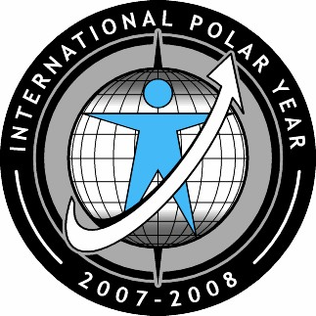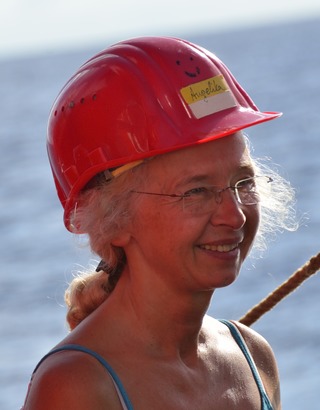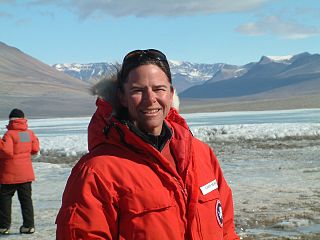Related Research Articles

The International Polar Years (IPY) are collaborative, international efforts with intensive research focus on the polar regions. Karl Weyprecht, an Austro-Hungarian naval officer, motivated the endeavor in 1875, but died before it first occurred in 1882–1883. Fifty years later (1932–1933) a second IPY took place. The International Geophysical Year was inspired by the IPY and was organized 75 years after the first IPY (1957–58). The fourth, and most recent, IPY covered two full annual cycles from March 2007 to March 2009.

The Agreed Measures for the Conservation of Antarctic Fauna and Flora is a set of environmental protection measures which were accepted at the third Antarctic Treaty Consultative Meeting in Brussels in 1964. The Agreed Measures were formally in force as part of the Antarctic Treaty System from 1982 to 2011, when they were withdrawn as the principles were now entirely superseded by later agreements such as the 1991 Protocol on Environmental Protection to the Antarctic Treaty. The Agreed Measures were adopted in order to further international collaboration within the administration of the Antarctic Treaty System and promote the protection of natural Antarctic ecological systems while enabling scientific study and exploration.

The Scientific Committee on Antarctic Research (SCAR) is an interdisciplinary body of the International Science Council (ISC). SCAR coordinates international scientific research efforts in Antarctica, including the Southern Ocean.

The Census of Marine Life was a 10-year, US $650 million scientific initiative, involving a global network of researchers in more than 80 nations, engaged to assess and explain the diversity, distribution, and abundance of life in the oceans. The world's first comprehensive Census of Marine Life — past, present, and future — was released in 2010 in London. Initially supported by funding from the Alfred P. Sloan Foundation, the project was successful in generating many times that initial investment in additional support and substantially increased the baselines of knowledge in often underexplored ocean realms, as well as engaging over 2,700 different researchers for the first time in a global collaborative community united in a common goal, and has been described as "one of the largest scientific collaborations ever conducted".

The SCARSouthern Ocean Continuous Plankton Recorder (SO-CPR) Survey was established in 1991 by the Australian Antarctic Division, of Environment, Water Heritage and the Arts, to map the spatial-temporal patterns of zooplankton and then to use the sensitivity of plankton to environmental change as early warning indicators of the health of the Southern Ocean. It also serves as reference for other Southern Ocean and Antarctic monitoring programs.
The Future of Marine Animal Populations (FMAP) project was one of the core projects of the international Census of Marine Life (2000–2010). FMAP's mission was to describe and synthesize globally changing patterns of species abundance, distribution, and diversity, and to model the effects of fishing, climate change and other key variables on those patterns. This work was done across ocean realms and with an emphasis on understanding past changes and predicting future scenarios.
The Census of Diversity of Abyssal Marine Life (CeDAMar) is a field project of the Census of Marine Life that studies the species diversity of one of the largest and most inaccessible environments on the planet, the abyssal plain. CeDAMar uses data to create an estimation of global species diversity and provide a better understanding of the history of deep-sea fauna, including its present diversity and dependence on environmental parameters. CeDAMar initiatives aim to identify centers of high biodiversity useful for planning both commercial and conservation efforts, and are able to be used in future studies on the effects of climate change on the deep sea.
MarBEF Data System was a project of the European Union's Network of Excellence which served as a platform to integrate and disseminate knowledge and expertise on marine biodiversity, with informative links to researchers, industry, stakeholders and the general public. The program was funded by the EU and formally ended in 2009. The data system's online Register of Resources (RoR) includes the details of over 1,000 European marine biology experts and their affiliated institutions and publications.

Nerida Gaye Wilson is an invertebrate marine molecular biologist at the Commonwealth Scientific and Industrial Research Organisation who has interests in diversity, systematics, phylogeny, phylogeography and behavior. Wilson has been instrumental in demonstrating the level of marine cryptic species complexes in Antarctic waters, testing the circumpolar distribution paradigm with molecular data, and using interdisciplinary approaches to show how Antarctic diversity may have been generated. Her work with NOAA on Antarctic Marine Living Resources has been used to regulate exploratory benthic fisheries.

Diana Harrison Wall was an American environmental scientist and soil ecologist. She was the founding director of the School of Global Environmental Sustainability, a distinguished biology professor, and senior research scientist at the Natural Resource Ecology Laboratory at Colorado State University. Wall investigated ecosystem processes, soil biodiversity and ecosystem services. Her research focused on the Antarctic McMurdo Dry Valleys and its Wall Valley was named after her. Wall was a globally recognized leader and speaker on life in Antarctica and climate change.

Dana Michelle Bergstrom is a senior researcher at the Australian Antarctic Division most notable for her work on identifying and mitigating risks against Antarctic and Sub Antarctic Ecosystems.

Angelika Brandt is the world leader in Antarctic deep-sea biodiversity and has developed, organised and led several oceanographic expeditions to Antarctica, notably the series of ANDEEP cruises, which have contributed significantly to Antarctica and deep-sea biology. Brandt was the senior scientist of ANDEEP which was devoted entirely to benthic research in the Antarctic abyss.
Carlota Escutia Dotti is a Spanish geologist, best known for her work on the geologic evolution of Antarctica and the global role of the Antarctic ice cap. Escutia is based at the Instituto Andaluz de Ciencias de la Tierra, Universidad de Granada and the High Council for Scientific Research (CSIC).

Bettine van Vuuren is the Registrar and a Member of the Executive at the University of Johannesburg. She is also a Professor of Zoology and Director of the Centre for Ecological Genomics and Wildlife Conservation at the University of Johannesburg.

Anna Wåhlin is a Swedish researcher on the Antarctic and the polar seas. She is a professor of physical oceanography at the University of Gothenburg and co-chair of the Southern Ocean Observing System.

Cinzia Verde is an Italian researcher in marine biochemistry at the National Research Council (CNR), Institute of Biosciences and BioResources (IBBR).

Siti Aisyah Binti Haji Alias is a Malaysian marine polar researcher and lecturer. As of August 2016, she is Associate Professor and Director of the National Antarctic Research Centre (NARC) in the Malaysian Antarctic Research Programme (MARP), at the University of Malaya. Her work focuses on the physiology of marine and polar microbes and fungi.

Alison Murray is an American microbial ecologist and Antarctic researcher, best known for studying the diversity, ecology and biogeography of Antarctic marine plankton dynamics of the plankton over the annual cycle; and her work demonstrating the existence of microbial life within an ice-sealed Antarctic lake. She studies how microorganisms persist and function in extremely cold and harsh environments, including those that lack oxygen and biological sources of energy.

The Ocean Biodiversity Information System (OBIS), formerly Ocean Biogeographic Information System, is a web-based access point to information about the distribution and abundance of living species in the ocean. It was developed as the information management component of the ten year Census of Marine Life (CoML) (2001-2010), but is not limited to CoML-derived data, and aims to provide an integrated view of all marine biodiversity data that may be made available to it on an open access basis by respective data custodians. According to its web site as at July 2018, OBIS "is a global open-access data and information clearing-house on marine biodiversity for science, conservation and sustainable development." 8 specific objectives are listed in the OBIS site, of which the leading item is to "Provide [the] world's largest scientific knowledge base on the diversity, distribution and abundance of all marine organisms in an integrated and standardized format".
Established in 2004, the Korea Polar Research Institute (KOPRI) is the lead agency for South Korea's national polar programme for the Arctic and the Antarctic and an advisor to the Government of South Korea. Its research projects have focused on biodiversity, climate change and geological evolution. The Institute participates in fora such as the Convention for the Conservation of Antarctic Marine Living Resources, the Council of Managers of National Antarctic Programs, the International Arctic Science Committee and the Scientific Committee on Antarctic Research (SCAR). KOPRI researchers and support staff operate on the icebreaker Araon, on campus at the Korea University of Science and Technology and in the country's three research stations — King Sejong and Jang Bogo in Antarctica, and Dasan at Ny-Ålesund, Svalbard. KOPRI sits within South Korea's Ministry of Oceans and Fisheries. Through international collaboration, KOPRI researches have undertaken studies in Alaska and Canada.
References
- ↑ CAML Annual report 2009 Archived 2013-04-13 at the Wayback Machine published by the Scientific Committee on Antarctic Research
- ↑ "Program Description on CoML Website". Archived from the original on 2017-10-14. Retrieved 2010-09-21.
- ↑ Agenda Item Archived 2013-04-13 at the Wayback Machine Antarctic Treaty Consultative Meeting 2010